![]()
![]()
![]()
Use LEFT and RIGHT arrow keys to navigate between flashcards;
Use UP and DOWN arrow keys to flip the card;
H to show hint;
A reads text to speech;
58 Cards in this Set
- Front
- Back
|
DNA |
Stands for deoxyribonucleic acid and is a molecule. It's shaped like a twisted double helix and is composed of long strands and is organised into structures called chromosomes |
|
|
Diploid |
Two complete sets of chromosomes one from each parent |
|
|
Filalo or F |
The children of that generation |
|
|
Phenotype |
IS the outward expression of the genes. e.g. what an organism looks like so it could be tall and short, tongue roller or non tongue roller and green or red e.t.c. |
|
|
Allele |
mutations create slightly different versions of genes called alleles. these differences in the DNA create each individual unique e.g. hair colour, height shape e.t.c |
|
|
Asexual reproduction |
they have one parent and the are identical to each other for e.g. binary fission, plant cuttings, buddings, runners, cloning |
|
|
Sexual reproduction |
2 parents e.g. gametes are used ( sperm and ovum) Fertilisation is involved with variations in appearance |
|
|
Advantages and disadvantages or asexual and sexual reproduction |
Asexual adv: in constant environment disadv: if environment changes all of them die off
sexual adv: population changes to become more suited to environment over time
disadv: different chance of survival if environment changes, some will die while others will survive |
|
|
Zygote |
the form of fertilization in reproduction when the sperm meets the ovum |
|
|
Haploid |
also written as n it's the half set of chromosomes |
|
|
What type and how many chromosomes are in mitosis |
22 normal chromosomes and a pair of x( female ) or Y (male) |
|
|
autosomes |
pair of homologous chromosomes
the gene is in exactly the same position in each homologous chromosomes pair |
|
|
Homozygous recessive/ dominant |
It means the same either with dominant or recessive alleles |
|
|
Heterozygous |
refers to different so it has one of each alleles so one dominant and one recessive |
|
|
what is the double helix made up of? |
It's made up of sugar and phosphate molecules that are connected by chemical bonds known as sugar phosphate backbones. Then there is a nitrogen base with G - C and A- T, three of these is called a triplet code |
|
|
What is a kayrotype and when is it used |
a karyrotype is a chart that shows a full set of chromosomes of a cell or an individual in order on the basis of their length. We use karyotypes on dividing cells becuase that's the only time they are visible ( under fingernails.) used to identify changes and differences in chromosomes. |
|
|
What happens if someone had extra or not enough chromosomes. |
They would die, or have a disability |
|
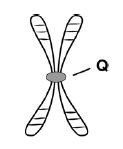
Label Structure of chromosome |

The centromere is where the chromosome is attached |
|
|
Difference between Identical and Fraternal twins |
Ovum splits into two in identical whereas in fraternal there are two each with a sperm for each |
|
|
What are proteins made up of and what do proteins do?
|
amenoacids, when these are put into different orders and combinations it produces thousands of different proteins. Proteins determine several things including eye colour, hair type tongue rolling. Genes need proteins in order to function |
|
|
What is a nucleotide made up of? |
Phosphate, sugar and one base |
|
|
Triplet code? |
a sequence of 3 bases |
|
|
in 46 chromosomes how many genes or proteins are there? |
30, 000 of each |
|
|
What is the complementary sequence for the DNA sequence? ATG TAC CGC GGG AAT
What happens if C is placed in front of the first A?
What if G is substituted for the 2nd T? |
TAC ATG GCG CCC TTA
CAT GTA CCG CGG GAA T - changes the whole sequence
ATG GAC CGC GGG AAT - only affects one amino acid and triplet code |
|
|
What are the stages of mitosis? |
Prophase, Interphase, Metaphase, Anaphase and telaphase |
|
|
How long does it take for cells to divide in mitosis? |
15 - 20 minutes |
|
|
What are the stages of meiosis? |
Prophase, Metaphase, Anaphase, Telaphase, Prophase 2, Metaphase 2, Anaphase 2, Telaphase 2 |
|
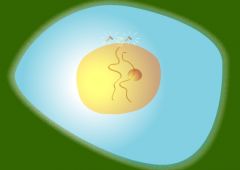
Explain what happens in prophase |
chromosomes condense ( short and thicker) and visible, nucleous dissapears, centriols migrate to opposite sides of cell, spindle fibre network forms, asters ( star shaped microtubles) appear |
|
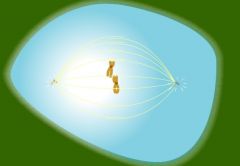
Explain what happens during Metaphase |
Chromosomes attach to spindle fibres and chromosomes allign in a line in the middle |
|
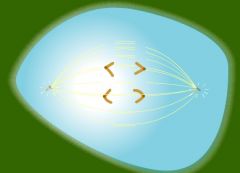
Explain what happens during Anaphase |
Spindle fibres shorten, chromotids pull apart and move to opposite poles |
|
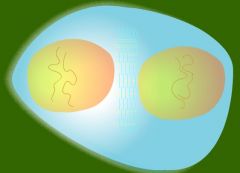
Explain what happens during telophase |
Nucleous and nucleus appears, chromosomes disappear, spindle fibres dissolve, centriols replicate |
|
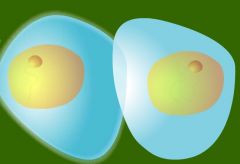
Explain what happens during Interphase |
Two identical daughter cells have been produced with the same number of chromosmes as their parent had. These diploid cells contain two copies of the same chromosomes |
|
|
What is the difference between meiosis and mitosis? |
Mitosis produces somatic cells whereas Meiosis is the process where sex cells or gametes are produced. In Mitosis there is only one chromotid on the a line of spindle fibres whereas in meiosis there are two on each as the chromosomes paired up creating a haploid. |
|
|
What is another name for 4 chromatids |
tetrad |
|
|
In meiosis explain prophase 1 |
Prophase 1 - chromosomes form tetrads, centriols start to separate, nucleous dissapears, centriols migrate to opposite sides of cell, spindle fibre network forms, asters become visible |
|
|
In meiosis explain metaphase 1 |
Metaphase 1 - A pair Chromosomes attach to spindle fibres and they allign in a line in the middle. They also cross over and they break off bits of different genes |
|
|
IN meiosis explain Anaphase 1and Telaphase 1 |
Anaphase 1- Spindle fibres shorten, tetrads separate from their pair and pull apart and move to opposite poles
Telaphase 1 - cell begins to split and becomes haploid with half amount of chromosomes, centriols replicated |
|
|
Explain what happens in the second lot of meiosis and Interphase 2 |
Second time - same as mitosis but with two cells
Interphase 2 - chromosomes disappear, different from original cell because they only have 2 chromosomes therefore they are haploid |
|
|
In meiosis Telaphase 2, the centriols duplicate why is this? |
Although they have half the number of chromosomes they need two centriols becuase it needs to create spermatids |
|
|
Mutations and an advantage |
A process that changes the DNA sequence, as a cell copies before dividing it creates a "typo". The most common form is insertion, deletion or substitution of a single base.
An advantage is that mutation gives you new variations that can give an individual a survival advantage |
|
|
What is a polar body? |
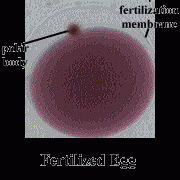
It is a female sex cell and its produced after each meiotic division and there is little nutrients in them so it dies. End up with one cell but its the biggest in human body |
|
|
When does female meiosis start and stop? |
It starts before birth and stops as Prophase 2, but the polar body forms in Anaphase 1. After birth the process continues when they hit puberty |
|
|
What happens when tetrads don't separate properly? |
this could result in diseases such as Down Syndrome and usually occurs in females. When the triads don't separate when dividing in mitosis or meiosis it's called disjunction when you have one less or one more chromosome and it affects development mentally and physically |
|
|
What happens when males get an extra y chromosome? |
They tend to get extra angry |
|
|
Define Chromosome |
A thread like structure found in nucleus of most living cells, each carrying genetic information in the form of genes |
|
|
Define Gene |
Segments of DNA located on chromosomes. They contain codes for the production of specific proteins |
|
|
Define Genotype |
the alleles that it actually has for e.g.
T = dominant, t= recessive, so if one species had TT (genotype is TT )x Tt (genotype is Tt) |
|
|
What does F1, F2, F3 mean? |
It means generation so F1 is the first generation, F2 is the second generation and so on |
|

Fill in this Punnet Square - Bb x bb and list phenotype and genotype. |
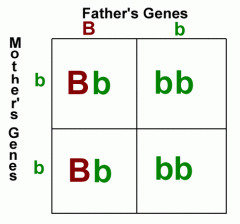
Genotype: 2/4 Bb, 2/4 bb
Phenotype: 2/4 father's genes, 2/4 mother's genes |
|
|
What is special about chromsome 6? |
IT controls eye and hair colour |
|
|
Define Co - dominance |
In cows you cross if you cross and red one and a whit one you'll end up with a white cow with red patches |
|
|
Define Incomplete Dominance |
When you cross a red rose with a white rose you'll end up with a pink rose |
|
|
Define Universal recipient |
It can receive everything but can not give anything |
|
|
What is an antigen? |
a type of immune system that allows only certain proteins into the body |
|
|
Define Universal donar? |
It can give to everyone but can only receive from itself |
|
|
What happens when you use gene splicing on an bactiria |
chemicals are added and causes the plastids to split and hope that they attach then if they attach new plastids are produced which creates more insulin |
|
|
How does cloning happen? |
You extract the nucleus of something you want to clone ( the rest of the cell dies), then you get an egg cell and remove that nucleus then add the nucleus of the thing you want to clone |
|
|
If you had a cell from the liver, what would it grow into? |
Another liver cell, because it has been told to produce a liver cell, if you wanted to produce something else it would have to be an egg cell |

